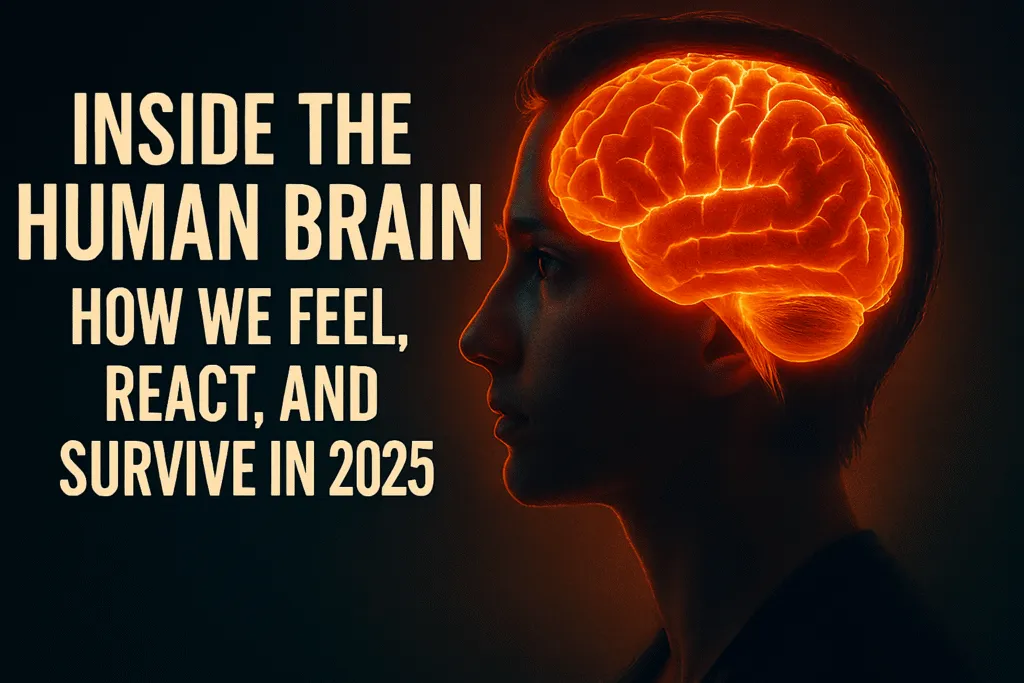Introduction – Understanding Emotions and the Brain
The human brain is one of the most complex and fascinating organs in the body, serving as the central hub for all our thoughts, actions, and emotions. Understanding how the human brain processes emotions is not only intriguing but also essential for improving mental health, decision-making, and interpersonal relationships. Emotions play a critical role in shaping our experiences, influencing everything from our behavior to our memory and learning abilities.
At the core of emotional processing in the human brain lies the limbic system, a group of interconnected structures that include the amygdala, hippocampus, and hypothalamus. These components work together to detect emotional stimuli, store emotional memories, and regulate responses. The amygdala, in particular, is crucial for recognizing fear and other intense emotions, triggering rapid reactions that help humans survive in dangerous situations. Meanwhile, the hippocampus links these emotional experiences with memories, allowing us to recall past events and learn from them.
The prefrontal cortex, located at the front of the human brain, plays a vital role in moderating emotional responses. It helps in rationalizing feelings, planning actions, and controlling impulses, enabling humans to navigate complex social environments effectively. Neurotransmitters like serotonin, dopamine, and oxytocin further influence emotional states, impacting mood, motivation, and social bonding.
Studying how the human brain processes emotions has become even more accessible with modern neuroimaging technologies, which allow scientists to observe emotional activity in real time. Understanding these processes can help individuals develop emotional intelligence, manage stress, and foster healthier relationships. By exploring the mechanisms behind emotional processing in the human brain, we gain valuable insights into human behavior, mental health, and the intricate connections between mind and body.
The Limbic System – The Emotional Core
The limbic system is often referred to as the emotional core of the human brain because it plays a central role in processing and regulating emotions. This complex network of structures, including the amygdala, hippocampus, hypothalamus, and cingulate gyrus, works together to detect emotional stimuli, form memories, and drive behavioral responses. The amygdala, a small almond-shaped structure, is particularly important for recognizing fear, anger, and other strong emotions, triggering immediate reactions that can be critical for survival.
The hippocampus, another key component of the limbic system, connects emotions with memory. This allows the human brain to remember emotionally significant events and use those experiences to guide future decisions. The hypothalamus, meanwhile, helps regulate the body’s physiological responses to emotions, such as changes in heart rate, blood pressure, and hormone release. Together, these structures create a finely tuned system that not only processes emotions but also ensures appropriate behavioral responses.
Understanding the limbic system is essential for grasping how the human brain interprets and reacts to emotional information. Modern neuroscience techniques, such as functional MRI, have allowed researchers to map activity within the limbic system, revealing how emotions influence learning, decision-making, and social interactions. By studying the limbic system, scientists can better understand mood disorders, anxiety, and other emotional challenges, leading to more effective treatments and therapies.
The limbic system demonstrates how deeply emotions are embedded in the human brain. Its intricate coordination of memory, perception, and physiological responses highlights the importance of emotional processing in everyday life, from personal relationships to critical decision-making. Recognizing the role of the limbic system helps us appreciate the complexity and power of our emotional experiences.
Role of the Amygdala – Fear, Anger, and Survival Instincts
The amygdala is a small, almond-shaped structure within the human brain that plays a crucial role in processing emotions, particularly fear and anger. Often considered the brain’s alarm system, the amygdala helps detect potential threats in the environment and triggers rapid emotional and physiological responses that are essential for survival. When the amygdala perceives danger, it activates the body’s fight-or-flight response, increasing heart rate, releasing stress hormones, and heightening alertness to prepare for immediate action.
Beyond fear, the amygdala also contributes to processing other intense emotions such as anger and aggression. It interacts closely with the prefrontal cortex, which helps regulate emotional responses, ensuring that reactions are appropriate and not purely instinctual. This connection allows humans to balance raw emotional impulses with rational decision-making, a key feature of emotional intelligence.
The amygdala also plays a vital role in emotional memory. Experiences linked to strong emotions are often more vividly remembered, thanks to the amygdala’s influence on the hippocampus. This ability helps the human brain learn from past experiences, avoid dangers, and adapt behavior for future situations.
Research using brain imaging techniques has highlighted how overactivity or dysfunction in the amygdala can contribute to anxiety disorders, phobias, and heightened stress responses. Understanding the role of the amygdala in emotional processing is therefore essential for both neuroscience and mental health. By studying how this small yet powerful structure operates, we gain deeper insight into the human brain’s mechanisms for fear, survival instincts, and emotional regulation, which are fundamental to navigating life’s challenges effectively.
Hippocampus – Linking Emotions with Memory
The hippocampus is a vital structure within the human brain that bridges the gap between emotions and memory. While it is widely known for its role in forming and storing new memories, the hippocampus also plays a key part in connecting these memories with emotional experiences. This connection allows the human brain to remember events more vividly when they are associated with strong feelings, whether positive or negative. For example, a joyful celebration or a frightening experience is often recalled more clearly because the hippocampus interacts with the amygdala to encode the emotional significance of the event.
In addition to memory formation, the hippocampus is essential for spatial navigation and context recognition. By linking emotional responses to specific situations or environments, it helps individuals anticipate outcomes and make informed decisions based on past experiences. This function is particularly important in learning and adapting behavior, as emotionally charged memories can guide future actions and improve survival instincts.
Research has shown that stress and trauma can significantly affect the hippocampus. Chronic stress, for instance, can impair its ability to form new memories and regulate emotions effectively, highlighting the delicate balance within the human brain. Understanding how the hippocampus links emotions with memory provides valuable insights into mental health conditions such as anxiety, depression, and post-traumatic stress disorder (PTSD).
By studying the hippocampus, scientists can better grasp how the human brain processes emotional experiences and stores them for future reference. This knowledge not only enhances our understanding of human behavior but also offers potential avenues for therapies and interventions aimed at improving emotional well-being and memory function.
Prefrontal Cortex – Rationalizing and Regulating Emotions
The prefrontal cortex is one of the most important regions of the human brain when it comes to managing emotions. Located at the front of the brain, it plays a crucial role in rational thinking, decision-making, and regulating emotional responses. While structures like the amygdala generate immediate emotional reactions, the prefrontal cortex helps moderate these impulses, ensuring that responses are appropriate to the situation. This balance between emotion and reason is essential for social interactions, problem-solving, and long-term planning.
In addition to controlling impulses, the prefrontal cortex contributes to emotional awareness and self-reflection. It allows individuals to analyze their feelings, understand why they react in certain ways, and make conscious choices about behavior. This capacity for emotional regulation is a key component of emotional intelligence, which helps the human brain navigate complex social environments and maintain healthy relationships.
The prefrontal cortex also interacts with other brain regions, such as the amygdala and hippocampus, to process emotional memories and responses. This collaboration enables the brain to learn from past experiences, anticipate potential outcomes, and make informed decisions based on both logic and emotion. Disruptions in prefrontal cortex function, whether due to injury, stress, or neurological conditions, can lead to impulsivity, poor judgment, or difficulty managing emotions.
Studying the prefrontal cortex provides valuable insights into how the human brain rationalizes and regulates emotions. Understanding this region helps researchers and mental health professionals develop strategies to enhance emotional control, reduce stress, and improve overall psychological well-being. By appreciating the role of the prefrontal cortex, we gain a deeper understanding of the intricate mechanisms that govern emotional balance in daily life.
Neurotransmitters – Chemicals That Influence How We Feel
Neurotransmitters are chemical messengers in the human brain that play a pivotal role in shaping emotions and influencing mood. These chemicals transmit signals between neurons, allowing different regions of the brain to communicate effectively and coordinate emotional responses. Key neurotransmitters such as serotonin, dopamine, and oxytocin are directly linked to how we experience happiness, motivation, attachment, and stress.
Serotonin is often associated with mood regulation, helping the human brain maintain emotional stability and prevent feelings of depression or anxiety. Dopamine, on the other hand, is linked to reward, pleasure, and motivation, driving us to seek experiences that bring satisfaction or reinforce positive behavior. Oxytocin, sometimes called the “bonding hormone,” strengthens social connections and feelings of trust, playing a crucial role in relationships and emotional well-being.
The balance of neurotransmitters in the human brain is essential for healthy emotional functioning. Imbalances can lead to mood disorders, anxiety, or difficulty managing stress. For example, reduced serotonin levels are commonly associated with depression, while dysregulated dopamine activity may contribute to impulsive or compulsive behaviors. External factors like diet, exercise, sleep, and stress levels can also influence neurotransmitter production and activity, highlighting the dynamic relationship between lifestyle and emotional health.
Advances in neuroscience have allowed researchers to study how neurotransmitters interact with different brain regions, such as the amygdala, hippocampus, and prefrontal cortex, to regulate emotions. Understanding the role of these chemical messengers in the human brain not only provides insights into emotional processing but also opens avenues for therapeutic interventions aimed at improving mental health and overall emotional balance.
Emotional Processing in Men vs. Women – Are There Differences?
The human brain processes emotions in ways that can vary between men and women, though the differences are often nuanced and influenced by both biology and social factors. Research has shown that certain brain regions, such as the amygdala and prefrontal cortex, may function differently across genders when responding to emotional stimuli. For instance, studies suggest that women tend to have stronger connectivity between the amygdala and other brain regions involved in emotional awareness, which may contribute to heightened sensitivity to emotional cues.
Men, on the other hand, often exhibit more lateralized activity in the amygdala, which can influence how emotions are experienced and expressed. These differences do not imply that one gender feels more deeply than the other, but rather that the human brain may engage distinct networks to process, interpret, and respond to emotions. Hormonal factors, such as levels of estrogen and testosterone, also play a role in shaping emotional responses and regulation.
Cultural and social conditioning further influences emotional processing. Societal expectations often dictate how men and women express emotions, which can impact behavior and even neural pathways over time. Women are generally encouraged to express feelings openly, while men may be socialized to suppress certain emotions, affecting how the human brain manages emotional experiences.
Understanding these differences is important for mental health, communication, and relationship dynamics. By studying how the human brain processes emotions in men and women, scientists and psychologists can develop more effective approaches for therapy, stress management, and emotional intelligence training. Recognizing that emotional processing is shaped by both biological and environmental factors allows for a more holistic understanding of human behavior and interpersonal interactions.
How Stress and Trauma Affect Emotional Processing
Stress and trauma have a profound impact on how the human brain processes emotions, often altering both immediate responses and long-term emotional patterns. When the brain encounters stressful situations, the amygdala becomes highly active, triggering the fight-or-flight response. This heightened state of alert prepares the body to react quickly but can also overwhelm other brain regions, such as the prefrontal cortex, which is responsible for rational thinking and emotional regulation. Prolonged stress can therefore impair the human brain’s ability to manage emotions effectively, leading to anxiety, irritability, and difficulty making decisions.
Traumatic experiences, especially during formative years, can further disrupt emotional processing. The hippocampus, which links emotions with memories, may become overactive or even structurally affected, causing emotionally charged memories to remain vivid and intrusive. This can result in heightened fear responses, emotional flashbacks, or difficulty distinguishing between past and present threats. Neurotransmitter imbalances caused by chronic stress or trauma can also affect mood, motivation, and social bonding, making it harder for the human brain to maintain emotional equilibrium.
However, the brain exhibits remarkable adaptability through neuroplasticity. With targeted interventions such as therapy, mindfulness, and stress management techniques, the human brain can rewire connections to better regulate emotions and reduce the long-term effects of trauma. Understanding how stress and trauma influence emotional processing is crucial for developing strategies to improve mental health, resilience, and emotional intelligence. By recognizing the impact of these factors on the human brain, we can take informed steps toward healing, balanced emotional responses, and overall psychological well-being.
Emotional Intelligence – Understanding and Managing Emotions
Emotional intelligence is the ability to recognize, understand, and manage emotions effectively, and it relies heavily on the functioning of the human brain. This skill involves perceiving one’s own emotions, empathizing with others, and regulating emotional responses in various situations. The prefrontal cortex, amygdala, and other brain regions work together to support these processes, allowing individuals to respond thoughtfully rather than react impulsively. High emotional intelligence enables better decision-making, stronger relationships, and improved mental health.
Self-awareness is a key component of emotional intelligence. By understanding how the human brain processes feelings, individuals can identify triggers, patterns, and emotional strengths or weaknesses. This awareness allows for more deliberate responses to challenging situations and helps prevent emotional overload. Empathy, another critical aspect, relies on the brain’s ability to process social and emotional cues, helping people connect with others and respond appropriately to their emotions.
Emotional regulation, supported by the prefrontal cortex, is essential for managing stress, controlling impulses, and maintaining focus. Neurotransmitters like serotonin and dopamine also play a role in stabilizing mood and supporting positive emotional experiences. Developing emotional intelligence involves practicing mindfulness, reflective thinking, and effective communication strategies, all of which strengthen the human brain’s ability to manage emotions.
By enhancing emotional intelligence, individuals can navigate personal and professional challenges more effectively. Understanding how the human brain interprets and regulates emotions not only improves self-management but also fosters healthier relationships, resilience, and overall well-being. Cultivating emotional intelligence is therefore a vital part of personal growth and psychological health.
Modern Research – Brain Imaging and Emotional Studies
Advances in neuroscience have allowed researchers to explore how the human brain processes emotions with unprecedented detail. Modern brain imaging techniques, such as functional magnetic resonance imaging (fMRI) and positron emission tomography (PET) scans, enable scientists to observe real-time activity in different brain regions while individuals experience or respond to emotions. These studies have revealed intricate networks connecting the amygdala, hippocampus, prefrontal cortex, and other areas, highlighting how the human brain integrates emotional and cognitive functions.
Through brain imaging, researchers have been able to map specific emotional responses to stimuli, such as fear, happiness, or sadness, and identify patterns of activation that vary among individuals. For example, heightened amygdala activity is often observed during fear or stress, while increased prefrontal cortex engagement reflects emotional regulation and decision-making. These insights have deepened our understanding of how emotions influence behavior, learning, and social interactions.
Modern research has also shed light on the impact of mental health conditions, trauma, and stress on emotional processing. By analyzing brain activity, scientists can identify irregularities or imbalances in neurotransmitter systems and neural connections that contribute to disorders such as anxiety, depression, or PTSD. This knowledge is instrumental in developing targeted therapies, interventions, and preventive strategies to support emotional well-being.
Understanding emotional processing through advanced imaging techniques not only enhances our knowledge of the human brain but also opens new possibilities for improving mental health and emotional intelligence. By studying how the brain reacts to and regulates emotions, researchers continue to uncover the complex mechanisms that shape human behavior, resilience, and overall psychological health.
Conclusion – Why Understanding Emotions Matters
Understanding how the human brain processes emotions is essential for navigating daily life, improving mental health, and fostering meaningful relationships. Emotions influence decision-making, memory, behavior, and social interactions, making them a central aspect of the human experience. By studying the roles of the limbic system, amygdala, hippocampus, prefrontal cortex, and neurotransmitters, we gain insight into how feelings are generated, regulated, and remembered.
Awareness of emotional processes helps individuals develop emotional intelligence, manage stress, and respond thoughtfully to challenging situations. It also provides valuable guidance for addressing mental health issues, trauma, and the effects of chronic stress. Modern research using brain imaging techniques continues to reveal the intricate networks and mechanisms underlying emotional processing, highlighting the complexity and adaptability of the human brain.
Ultimately, understanding emotions is not just a scientific pursuit—it has practical implications for everyday life. Recognizing how the human brain interprets and regulates emotions empowers individuals to improve relationships, make better decisions, and cultivate resilience. By appreciating the science behind our feelings, we can harness emotional awareness to enhance personal growth, psychological well-being, and overall quality of life.
Also Read: Inside Black Holes: The Shocking Truth Behind the Science (2025 Edition).
FAQs
1. What part of the human brain controls emotions?
Emotions are primarily regulated by the limbic system, which includes the amygdala, hippocampus, and hypothalamus. The prefrontal cortex also plays a key role in moderating and regulating emotional responses.
2. How does the amygdala affect emotional responses?
The amygdala is crucial for detecting threats and processing intense emotions like fear and anger. It triggers rapid physiological responses, such as the fight-or-flight reaction, to help humans respond to danger.
3. What role does the hippocampus play in emotions?
The hippocampus links emotions with memory, allowing emotionally significant events to be stored and recalled. This helps the human brain learn from past experiences and guide future decisions.
4. Can stress affect how the brain processes emotions?
Yes, chronic stress can overactivate the amygdala and impair the prefrontal cortex, reducing emotional regulation and increasing anxiety, irritability, and difficulty making decisions.
5. What are neurotransmitters, and how do they influence emotions?
Neurotransmitters like serotonin, dopamine, and oxytocin act as chemical messengers in the human brain. They regulate mood, motivation, pleasure, social bonding, and emotional stability.
6. Are there differences in emotional processing between men and women?
Research indicates some differences in brain connectivity and hormone influences, which may affect emotional sensitivity and regulation. Social and cultural factors also play a significant role.
7. How can understanding emotions improve mental health?
By learning how the human brain processes emotions, individuals can develop emotional intelligence, manage stress, improve relationships, and adopt strategies to enhance overall psychological well-being.
8. What modern tools help study emotions in the brain?
Techniques like fMRI (functional magnetic resonance imaging) and PET scans allow researchers to observe real-time brain activity, helping identify how different regions process and regulate emotions.













